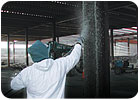
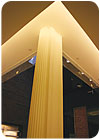
Ornamental steel column with intumescent fireproofing, made by AD Firefilm II, applied at Bloomingdales department store in Soho, New York.
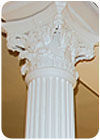
Ornamental column with AD Firefilm II intumescent fireproofing at Bloomingdales.
As part of my duties as a member of the PSFC, I investigate and educate the members on the current issues affecting our industry. In addition, I am the fireproofing segment instructor of an AIA-approved six-credit course that the PSFC provides to architects for continuing education credits. In that course, I cover all aspects and issues of spray fireproofing-from history to building codes.
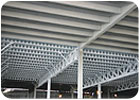
A combination of castelated ("smart beams") and wide flange steel beams with high-density fireproofing Cafco Fendolite M II, from Solatek, at The Grand Avenue Bus Facility, Queens.
Industry challenges
The most important issue facing our industry today is the reduction in the use of spray fireproofing due to the manipulation and amending of the International Building Code. In addition, independent state and municipal agencies that work outside the local jurisdictions make value judgments based on the fact that a structure is deemed non-combustible and therefore does not need to be fireproofed.The current building codes are in dire need of change if the fireproofing industry is to survive as a whole. Organizations, such as AWCI and the NFCA, are at the forefront in the fight to revamp these codes. I have witnessed an amazing decline in the use of spray fireproofing in public schools, office buildings and other public institutions. It seems that the design community is using the building codes (which are minimum standards) to exclude fireproofing from projects.
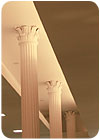
Intumescent fireproofing applied to ornamental columns at Bloomindales Soho.
In the case of fire, if the sprinklers fail-and they can-spray fireproofing may be the only thing protecting fire fighters from a building's collapse, not to mention property loss. It is up to everyone to be aware of this problem and support those who are working very hard to correct this problem.
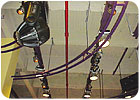
Exposed fireproofing in a retail store. Product by Southwest Vermiculite Type 5.
Fireproofing contractors offering bids based upon the use of restrained assemblies is inappropriate unless the bid documents state otherwise. The design professionals, construction managers and general contractors need to be better educated as to this requirement and not be misled in the quest to spend less money. They should be aware and responsible to build safely and according to the standards that have been set.
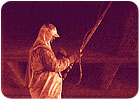
Sprayer at the PATH Terminal Restoration Site, at Ground Zero.
Certification
An issue that is at the forefront is the certification of fireproofing contractors: If plumbers and electricians require certification, why not fireproofers?Fireproofers provide a life safety aspect to buildings and they should have the knowledge and integrity that can only be ensured with certification and licensing. As an active member of the fireproofing community, I have joined the newly formed NFCA, an organization comprised of contractors and material suppliers who are looking to better the fireproofing industry.
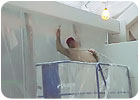
Fireproofer applying intumescent fireproofing at the New York Hilton Health Club. Material supplied by AlbiClad TF.
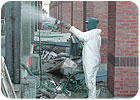
Spraying mineral fiber fireproofing at the Highlands Project, in Brewster, N.Y.
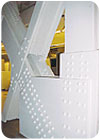
Building truss four-hour rated with AlbiClad TF, at MTA World Headquarters, 2 Broadway, New York.
If you read this article, please circle number 174.
